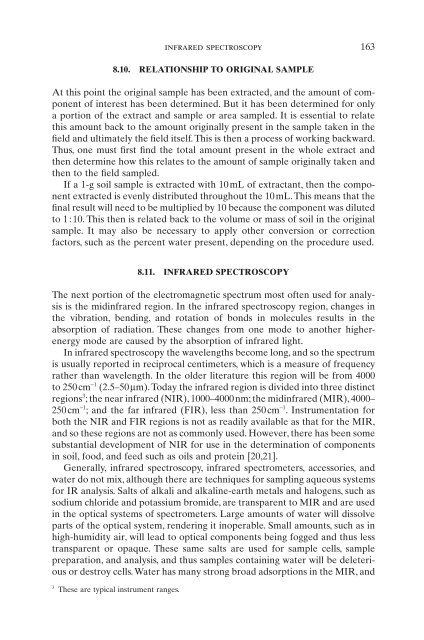Introduction to Soil Chemistry
Introduction to Soil Chemistry
Introduction to Soil Chemistry
Create successful ePaper yourself
Turn your PDF publications into a flip-book with our unique Google optimized e-Paper software.
infrared spectroscopy 163<br />
8.10. RELATIONSHIP TO ORIGINAL SAMPLE<br />
At this point the original sample has been extracted, and the amount of component<br />
of interest has been determined. But it has been determined for only<br />
a portion of the extract and sample or area sampled. It is essential <strong>to</strong> relate<br />
this amount back <strong>to</strong> the amount originally present in the sample taken in the<br />
field and ultimately the field itself. This is then a process of working backward.<br />
Thus, one must first find the <strong>to</strong>tal amount present in the whole extract and<br />
then determine how this relates <strong>to</strong> the amount of sample originally taken and<br />
then <strong>to</strong> the field sampled.<br />
If a 1-g soil sample is extracted with 10mL of extractant, then the component<br />
extracted is evenly distributed throughout the 10mL. This means that the<br />
final result will need <strong>to</strong> be multiplied by 10 because the component was diluted<br />
<strong>to</strong> 1:10. This then is related back <strong>to</strong> the volume or mass of soil in the original<br />
sample. It may also be necessary <strong>to</strong> apply other conversion or correction<br />
fac<strong>to</strong>rs, such as the percent water present, depending on the procedure used.<br />
8.11. INFRARED SPECTROSCOPY<br />
The next portion of the electromagnetic spectrum most often used for analysis<br />
is the midinfrared region. In the infrared spectroscopy region, changes in<br />
the vibration, bending, and rotation of bonds in molecules results in the<br />
absorption of radiation. These changes from one mode <strong>to</strong> another higherenergy<br />
mode are caused by the absorption of infrared light.<br />
In infrared spectroscopy the wavelengths become long, and so the spectrum<br />
is usually reported in reciprocal centimeters, which is a measure of frequency<br />
rather than wavelength. In the older literature this region will be from 4000<br />
<strong>to</strong> 250cm -1 (2.5–50mm).Today the infrared region is divided in<strong>to</strong> three distinct<br />
regions 3 ; the near infrared (NIR), 1000–4000nm; the midinfrared (MIR), 4000–<br />
250cm -1 ; and the far infrared (FIR), less than 250cm -1 . Instrumentation for<br />
both the NIR and FIR regions is not as readily available as that for the MIR,<br />
and so these regions are not as commonly used. However, there has been some<br />
substantial development of NIR for use in the determination of components<br />
in soil, food, and feed such as oils and protein [20,21].<br />
Generally, infrared spectroscopy, infrared spectrometers, accessories, and<br />
water do not mix, although there are techniques for sampling aqueous systems<br />
for IR analysis. Salts of alkali and alkaline-earth metals and halogens, such as<br />
sodium chloride and potassium bromide, are transparent <strong>to</strong> MIR and are used<br />
in the optical systems of spectrometers. Large amounts of water will dissolve<br />
parts of the optical system, rendering it inoperable. Small amounts, such as in<br />
high-humidity air, will lead <strong>to</strong> optical components being fogged and thus less<br />
transparent or opaque. These same salts are used for sample cells, sample<br />
preparation, and analysis, and thus samples containing water will be deleterious<br />
or destroy cells.Water has many strong broad adsorptions in the MIR, and<br />
3 These are typical instrument ranges.
















